Explore the world of “Animals that Start with T”! Do you find yourself scratching your head when trying to list animals beginning with the letter T? Fret no more! We have compiled a list of animals starting with T for you.
Read the entire article or jump to any section:
Overview of animals that start with T
1. Takin

| Scientific Name | Budorcas taxicolor |
| Where It Lives | South Asia, East Asia, Southeast Asia |
| What It Eats | Grasses, leaves, bamboo, flowers |
| Conservation Status | Vulnerable (VU) according to the IUCN Red List |
Fun Fact: The Takin has been recorded to jump up to six feet in the air.
Takins can be found living in forests valleys and grass-covered alpine zones of the Himalayas.
This animal looks like a cross between a cow, a goat, and an antelope. It has a complicated network of sinuses to warm up the frigid mountain air before it gets to the lungs. They live in social groups and sleep a lot like dogs – with their heads resting on their front legs.
2. Tang

| Scientific Name | Paracanthurus hepatus |
| Where It Lives | Pacific, Indian, and Atlantic oceans |
| What It Eats | Plankton, Algae |
| Conservation Status | Least Concern (LC) according to the IUCN Red List |
Fun Fact: Some tangs can lie still and play dead when a predator is nearby.
These brightly-colored fish are found in the tropical parts of the Pacific, Indian, and Atlantic oceans.
They usually travel in large schools and add a vivid display to indoor aquariums. During mating the males and females quickly swim up to the surface of the water while releasing their sperm and eggs. The tiny eggs hatch after 24 hours.
3. Tapanuli Orangutan

| Scientific Name | Pongo tapanuliensis |
| Where It Lives | Indonesia |
| What It Eats | Caterpillars, conifer cones, fruits |
| Conservation Status | Critically Endangered (CR) according to the IUCN Red List |
Fun Fact: Orangutans are too large to leap through the trees like monkeys. Instead, they swing from branch to branch.
The Tapanuli Orangutan inhabits tropical and subtropical forests in Indonesia.
These are the second largest tree-living primates and the rarest of the great ape species. These solitary animals are mostly seen in trees and are active during the day. During evenings they build nests high up in trees. After 9 months of pregnancy, females give birth to a lone baby and care for it for the first few years of its life.
4. Tapir

| Scientific Name | Tapiridae |
| Where It Lives | Central and South America, North East Asia |
| What It Eats | Plants, fruits, leaves |
| Conservation Status | Endangered (EN), Vulnerable (VU) according to the IUCN Red List |
Fun Fact: A group of tapirs is called a candle.
There are 4 Tapir species that live in jungle and forest areas in Central America, South America, and North East Asia.
These strange animals look like a cross between donkeys and elephants. They have an elongated snout called a proboscis to gather food. These trunk-like snouts of them can move in any direction which helps them grab food that otherwise would have been out of reach.
5. Tarantula Hawk

| Scientific Name | Pepsis albocincta |
| Where It Lives | Africa, Asia, the Americas, Oceania |
| What It Eats | Pollen, nectar |
| Conservation Status | Least Concern (LC) according to the IUCN Red List |
Fun Fact: When a female Tarantula Hawk wants to lay, it paralyzes a spider and lays its egg on it. The larva then burrows into the poor spider and pupates. Then the pupa bursts out from the spider when it’s fully grown.
The Tarantula hawk is a wasp that is found on almost every continent around the world.
The Tarantula Hawk gets its name from its habit of paralyzing tarantula spiders, dragging them to their nests, and laying its eggs in it! The stings of these wasps cause incredible pain, so much so that wasp-eating animals avoid them at all costs.
6. Tarsier
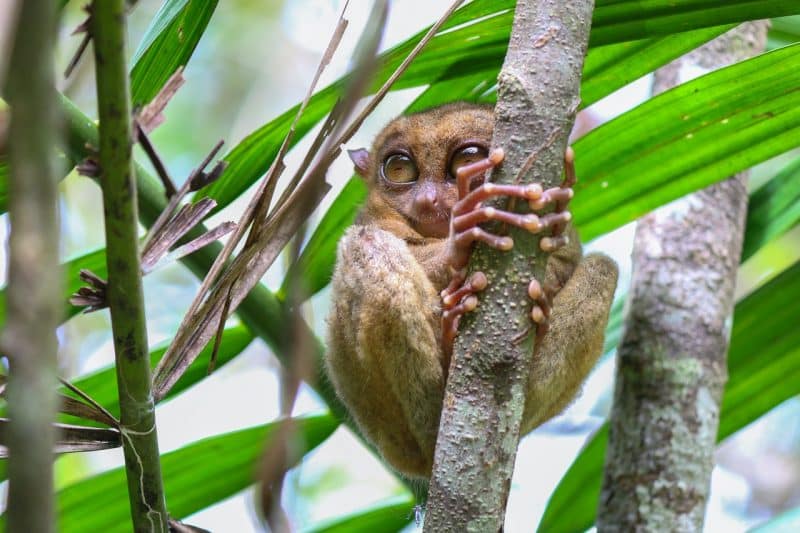
| Scientific Name | Tarsius |
| Where It Lives | Malaysia, Indonesia, Philippenes |
| What It Eats | Birds, Insects, Lizards |
| Conservation Status | Endangered (EN) according to the IUCN Red List |
Fun Fact: Tarsiers have such tiny brains that one of their eyes weighs more than it.
Tarsiers are primates that live in Malaysia, Indonesia, and the Philippines.
These arboreal and nocturnal animals have long fingers and toes and well-developed eyes to see in the dark. They tend to live solitary lives clinging to tree branches, using their strong hindlegs to make incredible leaps from branch to branch.
7. Teddy Bear Hamster

| Scientific Name | Mesocricetus auratus |
| Where It Lives | Western Asia |
| What It Eats | Seeds, nuts, insects, ants, flies |
| Conservation Status | Endangered (EN) according to the IUCN Red List |
Fun Fact: The Teddy Bear Hamster cheek pouches can carry twenty percent of its body weight in food.
The adorable Teddy Bear Hamster can be found in fertile and agricultural areas in Syria and Turkey. But also in the homes of many pet owners!
These cute animals have the large ears and small dark eyes of a stuffed Teddy Bear. And they’re fluffy too! Female Teddy bear hamsters will carry their young inside their pouches to safety when danger approaches.
8. Termite
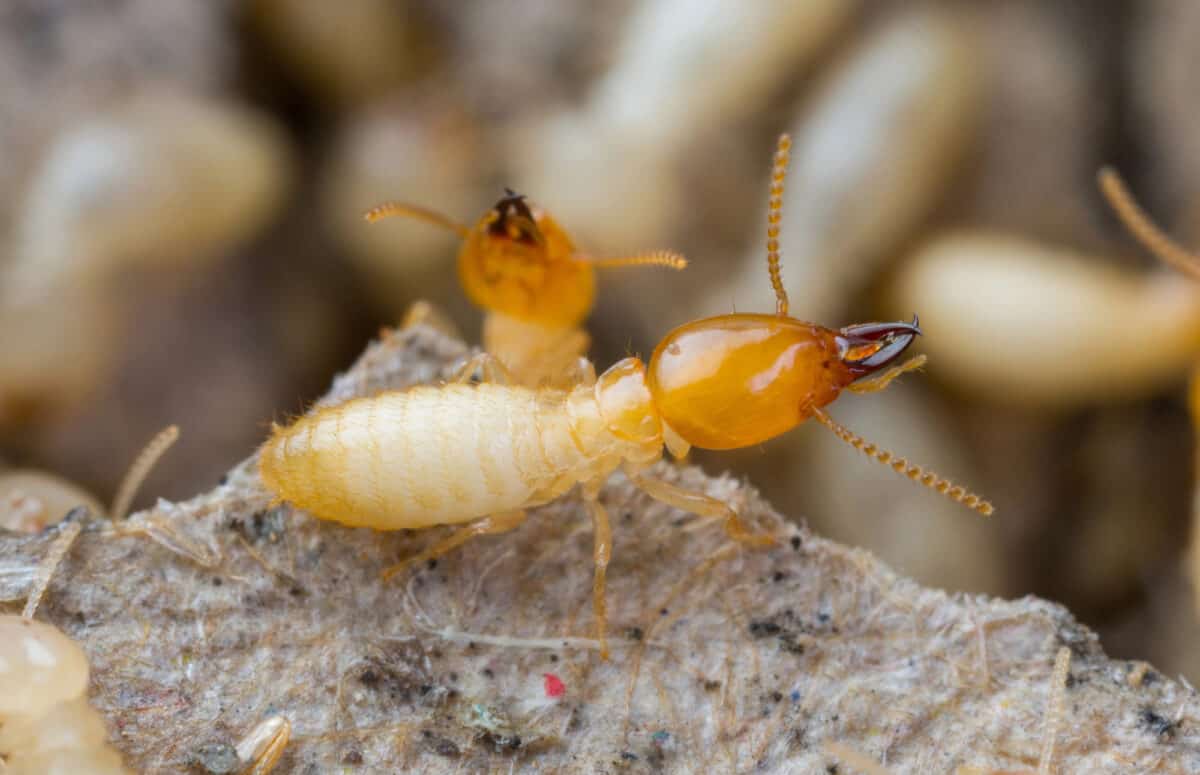
| Scientific Name | Isoptera |
| Where It Lives | Worldwide |
| What It Eats | Plant matter, wood, grass |
| Conservation Status | Least Concern (LC) according to the IUCN Red List |
Fun Fact: Termites don’t sleep at all, ever!
You can find these pesky insects everywhere. They build mounds up to nine meters tall in the wild. But you can also find them in your home, munching on your favorite wooden chair.
These six-legged insects have massive heads compared to their bodies, and most of them are blind. The queen of their colony is a massive 4 inches long, especially compared to the rest of the colony’s average size of 0.3 inches!
9. Thorny Devil

| Scientific Name | Moloch horridus |
| Where It Lives | Australia |
| What It Eats | Ants, insects |
| Conservation Status | Least Concern (LC) according to the IUCN Red List |
Fun Fact: Despite its looks, the Thorny Devil isn’t harmful. Its diet consists of just ants.
Like most scary-looking animals, the Thorny Devil is native to mainland Australia where they inhabit arid scrublands and deserts.
These animals are well adapted to the dry regions they live in, absorbing water through the capillaries on their scales – meaning they can hydrate by digging holes in the sand! Their appearance acts as a defense against predators, and they inflate their chests to appear even bigger when threats appear.
10. Tibetan Mastiff

| Scientific Name | Canis lupus |
| Where It Lives | Worldwide |
| What It Eats | High-quality dog food and animal protein |
| Conservation Status | Not Endangered |
Fun Fact: The Tibetan Mastiff sheds once a year, unlike other dog breeds.
These large dogs are native to the mountains of Tibet. Their shaggy coats protect them from the frigid temperatures in those highlands.
These highly intelligent dogs tend to get bored quickly and require entertainment or activity to release pent-up energy and to avoid acts out of frustration. They make loving and protective pets and have been seen showing aggression toward potential dangers imposed on their owners.
11. Tick

| Scientific Name | Ixodida |
| Where It Lives | Worldwide |
| What It Eats | Mammals, birds, reptiles, amphibians |
| Conservation Status | Least Concern (LC) according to the IUCN Red List |
Fun Fact: Ticks inject a chemical that prevents their host from feeling the pain of a bite.
Ticks live around the world in bushy, wooded, grassy and leafy areas. Here they patiently wait for a host to feed on.
These little guys are arachnids, meaning that they are closer to spiders than insects. They only feed on blood that they get from their hosts, and some species cause Lyme disease in humans if they are attached for longer than 24 hours.
12. Tiger
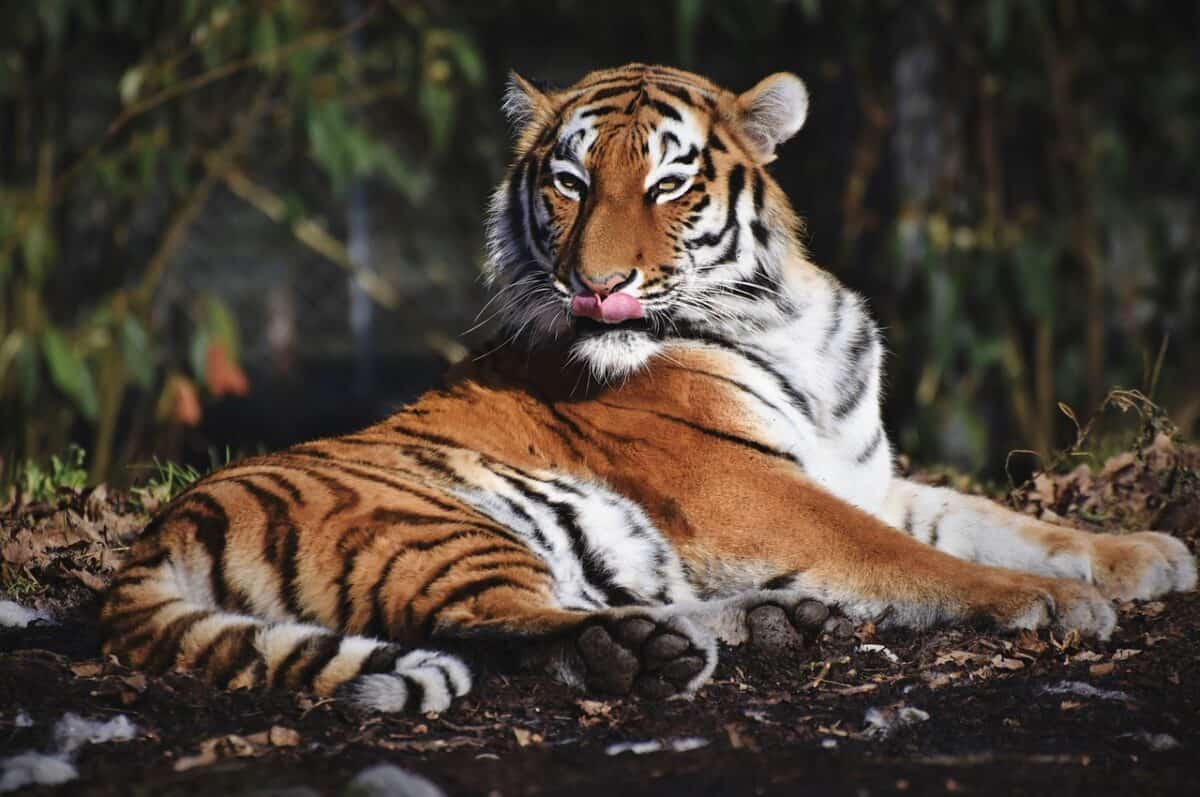
| Scientific Name | Panthera tigris |
| Where It Lives | South Asia, Southeast Asia, East Asia |
| What It Eats | Deer, buffalo, pigs, antelope, monkeys, hares |
| Conservation Status | Endangered (EN) according to the IUCN Red List |
Fun Fact: Tiger stripes are unique to the individual.
The endangered tiger lives in forests in South and South East Asia.
Although they are terrestrial animals, tigers love water and can swim up to 18 miles a day. These extremely strong predators sometimes carry their hunt into the vegetation to eat in peace. Fully grown tigers sometimes even go 2 weeks without eating, but when they eat again they can put away about 75 pounds of meat in one sitting!
13. Toadfish

| Scientific Name | Batrachoididae |
| Where It Lives | Worldwide |
| What It Eats | Fish, sea worms, mollusks, crustaceans |
| Conservation Status | Least Concern (LC) according to the IUCN Red List |
Fun Fact: Toadfish are highly poisonous but are safe to eat when cooked properly.
Toadfishes live in lagoons, bays and coastal areas of oceans across the world.
These fish look like toads, and even more, they make the same croaking souds toads to. It can even be heard out of the water they make them in! They are extremely poisonous, and although they are much deadlier than black widow spiders, no antidote for their poison exists.
14. Tsetse Fly

| Scientific Name | Glossina |
| Where It Lives | Africa |
| What It Eats | Blood of mammals |
| Conservation Status | Least Concern (LC) according to the IUCN Red List |
Fun Fact: Throughout its lifespan of four months, the female Tsetse fly is impregnated once by the male. But it stays pregnant till it dies, releasing its offspring one at a time.
These large blood-sucking flies majorly live in Sub-Saharan Africa.
The Tsetse fly’s bite can transmit a parasite that attracts the Central nervous system and is the cause of thousands of deaths a year. About the similar size as a houselfy, these deadly flies have sharp teeth that penetrate their prey’s skin before releasing a anit-coagulating chemical into their prey.
15. Tuna

| Scientific Name | Scombridae |
| Where It Lives | Atlantic, Indian and Pacific Oceans |
| What It Eats | Fish, mollusks, crustaceans |
| Conservation Status | Least Concern (LC) according to the IUCN Red List |
Fun Fact: Tunas are prolific breeders and can produce millions of eggs yearly.
Tunas inhabit the tropical to temperate waters of the Atlantic, Indian and Pacific Oceans.
With their sleek streamlined bodies they are some of the fastest fishes in the world. These fish tavel thousands of miles a year and can swim at speeds of 40 mph, making them very succesful predators. Tunas can lay thousands of eggs per year and these hatch quite quickly. However, it takes a while for them to reach adulthood.
16. Tarpon

| Scientific Name | Megalops |
| Where It Lives | Antlantic Ocean, Indo-Pacific Ocean |
| What It Eats | Fish, invertebrae |
| Conservation Status | Vulnerable (VU) according to the IUCN Red List |
Fun Fact: Tarpons have a swim bladder that they fill with air to allow them to tolerate oxygen-poor waters.
There are two Tarpon fish species, namely they Atlantic an Pacific tarpon, and although they mostly live in oceans they can also be found in freshwater.
These acient fish evolved approximately 113 million years ago during the Cretaceous period. Tarpons weigh about 100 pounds and grow to about 6 feet, with the largest ever recorded tarpon weighing in at 286 pounds!
17. Tasmanian Devil
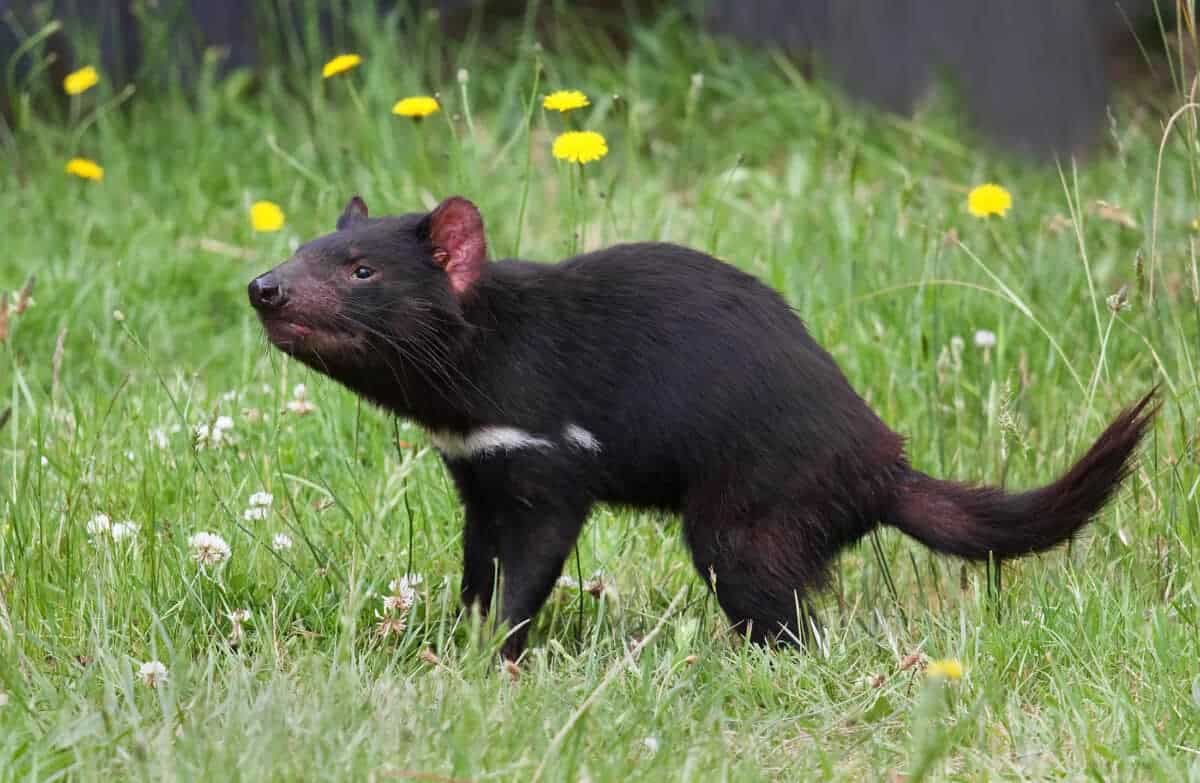
| Scientific Name | Sarcophilus harrisii |
| Where It Lives | Australia |
| What It Eats | Frogs, birds, fish, small mammals, reptiles |
| Conservation Status | Endangered (EN) according to the IUCN Red List |
Fun Fact: Tasmanian devils can open their jaws to 80 degrees when consuming prey.
As the name implies, these animals are found only on the island of Tasmania where they live in dry forests, shrublands, and open woodlands.
They look like little bears and can be pretty aggressive over food. In fact, these marsupials have one of the strongest bites in the animal kingdom thanks to their exceptionally strong jaw muscles. Tasmanian Devils store their excess fat in their tails, and despite being great climbers are clumsy on the ground.
18. Tetra
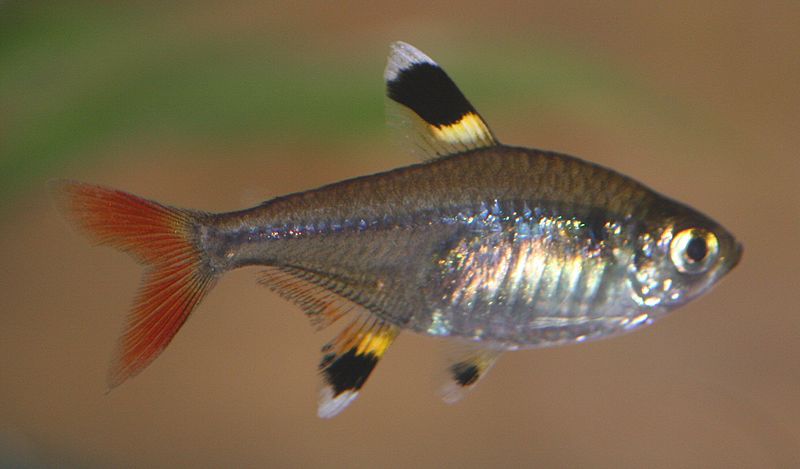
| Scientific Name | Paracheirodon Axelrodi |
| Where It Lives | South America, Africa, Cental America |
| What It Eats | Algae, shrimp, brine, plankton |
| Conservation Status | Least Concern (LC) according to the IUCN Red List |
Fun Fact: Tetra are pretty hardy, and as such, they are good aquarium fishes.
The tiny Tetra is a native fish of the freshwater streams in South America, Central America and Africa.
These colorful animals travel in schools of hundreds and act much more energetic in bigger groups than when alone, most likley becaue they feel secure. In the wild these tiny fish can live up to 10 years, however captivity shortens their lifespan significanytly.
19. Tibetan Fox
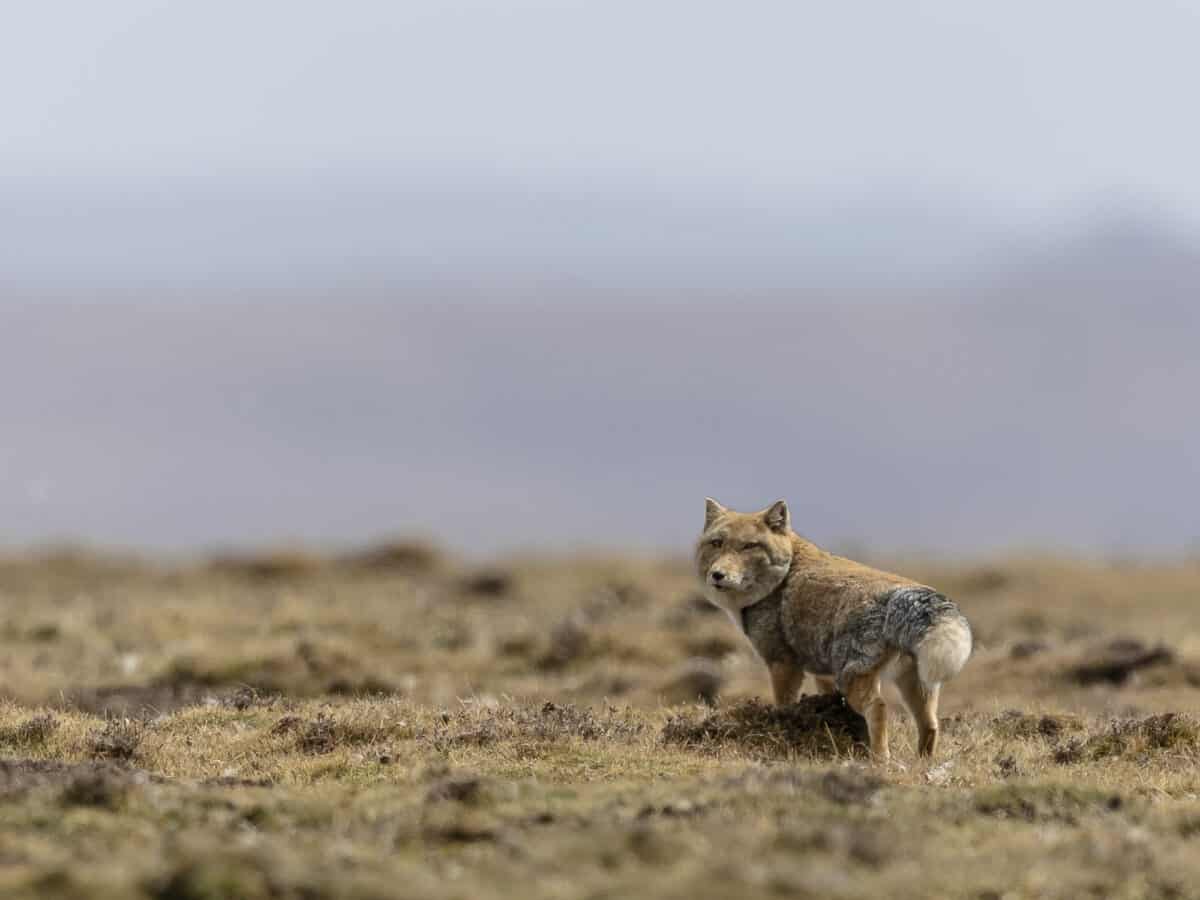
| Scientific Name | Vulpes ferrilata |
| Where It Lives | South Asia, East Asia |
| What It Eats | Pikas, rodents, hares, lizards |
| Conservation Status | Least Concern (LC) according to the IUCN Red List |
Fun Fact: Tibetan foxes are not territorial and have been seen working with bears to hunt down prey.
Tibetan foxes live far away from civilization in semi-arid grasslands and shrublands in China, Nepal, India, and Bhutan.
These square-faced foxes blend well into the landscapes that they live with their small family groups. These foxes live in dens that can have up to four entrances. During the day they rest in these dens, as well as raise their young and hide from danger here.
20. Tiger Beetle

| Scientific Name | Cicindelinae |
| Where It Lives | Worldwide |
| What It Eats | Insects, spiders |
| Conservation Status | Endangered (EN) according to the IUCN Red List |
Fun Fact: Tiger beetles have a powerful bite that is very painful and can draw blood.
Tiger beetles live in tropical and temperate climates across the world, with their largest population in Southeast Asia.
Tiger beetles spend most of their lives as larvae living underground, as they only last a few months as adults before they die. They can spend one to four years as larvae. Although small, these beetles have incredibly strong mandibles and a bite from them is sure to draw blood!
Summary of Animals that Start with T
From tiger beetles to the mighty tigers themselves, these animals all begin with the letter T. How many of them did you know? Here is another fascinating list of animals that start with m.
Get the full Alphabet here.
- Animals That Start With A
- Animals That Start With B
- Animals That Start With C
- Animals That Start With D
- Animals That Start With E
- Animals That Start With F
- Animals That Start With G
- Animals That Start With H
- Animals That Start With I
- Animals That Start With J
- Animals That Start With K
- Animals That Start With L
- Animals That Start With M
- Animals That Start With N
- Animals That Start With O
- Animals That Start With P
- Animals That Start With Q
- Animals That Start With R
- Animals That Start With S
- Animals That Start With U
- Animals That Start With V
- Animals That Start With W
- Animals That Start With X
- Animals That Start With Y
- Animals That Start With Z
- Animals and Wildlife in Antarctica - October 21, 2024
- Animals and Wildlife in the Bahamas - October 20, 2024
- Discover the Fascinating World of Long-Neck Dinosaurs - October 20, 2024

